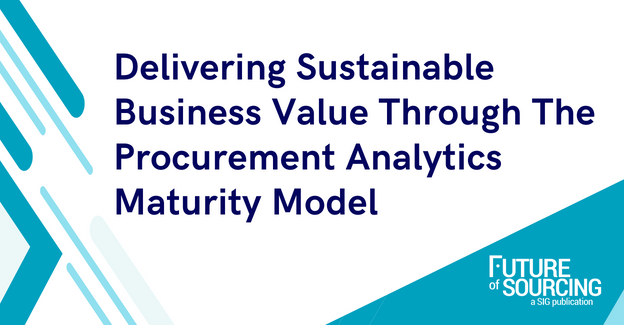In an exclusive article Siddharth Poddar - Practice Head, Procurement Insights at Polestar Solutions shares his insights into the need for procurement analytics maturity model, key steps to assess and improve procurement analytics maturity and how to build a sustainable procurement analytics program.
It’s been 3 years since the start of Covid-19 pandemic, and it is hard to believe what all the world has gone through in these 36 months. Fortunately, barring a few countries, Covid-19 has all but fallen out of newspaper headlines and businesses all over the globe are trying to get to the pre pandemic velocity. However, business leaders continue to exhibit pessimism towards the economic environment citing inflation, supply chain risks, trade policy shifts, global energy crisis and fear of an upcoming global recession.
Organizations have responded in a variety of ways to prepare for this economic uncertainty and ever-looming recession. Some responses take most of the limelight like employee layoffs, restructuring, management changes, passing on cost increases to customers, reducing pack sizes to keep price point and margins etc. Many other organizations are looking inwards to find the efficiencies required to face a tougher market.
One area that gets a lot of airtimes, but little progress, in these introspections is leveraging of data by Procurement leaders in decision making. Year after year, CPO surveys identify increased usage of data as a key priority for procurement leadership, yet few make tangible progress, as evident by this 2023 survey of Global CPOs where a whopping 85% are aiming to expand the use of data.
Figure 1: CPO perspective on leveraging data for Procurement Analytics
The need for Procurement Analytics Maturity Model
While every organization desires to have an industry leading mature procurement function, each will have their own challenges and journey towards maturity. For example, traditional brick-and-mortar companies with manual workflows will have a different starting point as compared to digital native companies.
To level the playing field, Procurement organizations are investing heavily in digital transformation projects and an assortment of next-gen procurement technologies and tools. The ROI, however, of such investments remains to be realized or appropriately evaluated.
At a fundamental level, procurement is expected to serve 4 key objectives:
Figure 2: Procurement Value Delivery Areas
Enhanced service delivery – Make the process efficient for business users and enhance procurement engagement by businesses.
Improved supplier relationships – Ensure continuity of supply, improve supplier performance, and risk profile and offer meaningful growth opportunities to key suppliers.
Improved bottom-line – Ensure performance-to-budget, P&L savings delivery, working capital improvement and many others
Visibility towards growth drivers – Help businesses make sustainable choices in procurement decisions, embed AI/ML in decision making and explore enrichment via third party data.
Measurement of these crucial Procurement objectives can be enabled though an efficient Procurement Analytics program. However, many organizations face certain roadblocks which deter them from extracting key insights from their procurement data. Oftentimes quality of data and poor integration are the two most cited factors that prevent adoption of analytics heavy procurement decision framework.
These 2 reasons are, however, just the tip of the iceberg. More factors need to be scrutinized to evaluate the maturity of Procurement Analytics in an organization.
Key steps to assess and improve procurement analytics maturity:
To demystify the aura around procurement analytics and making it work for you requires clarity of thought, prioritization, a whole lot of collaboration with IT and business functions and a significant amount of patience. Below is a framework for Procurement Leaders to consider when deciding to assess the maturity of their Procurement Analytics and to make step changes to it.
1. Assessment of key analytics use cases as it relates to each of the Procurement value delivery area (Fig 2).
Identification of prioritized analytics use cases standing for each of the value delivery areas is of critical importance. There may be an overwhelming number of use cases requiring optimization hence prioritization will help immensely in maintaining focus. For a relatively nascent procurement function improving Req to PO cycle time to address business requirements may take more priority than improving contract cycle time that is less frequent activity.
2. Detailed evaluation of each analytics use case on the 5 components (Fig 3).
For the prioritized list of analytics use cases, try answering some fundamental questions to evaluate the maturity. Sample set of questions may include, but are not limited to:
Data Sources
- Are all data sources contributing to the use cases known and used consistently?
- Can the data produced via the sources be considered reliable?
Data Estate
- How effective is the collaboration between IT and Procurement function?
- Can the data from these data sources be sent to a data warehouse in an automated fashion?
- What transformations need to be done to the data before it goes into DW?
Reporting Framework
- Is there a standard reporting cadence being followed?
- Is the reporting done via a system/application instead of on excel?
- What leading and lagging metrics are being tracked?
- Are these metrics representative of what we want to optimize?
Decision Framework
- Is there a team that is tasked with reading insights out of the business metrics?
- Are their corrective actions taken based on the data points?
Advanced analytics
- Do you use Machine Learning models to predict data points?
- Do you see any value in advance analytics models created by data science teams?
3. Introspection of the results and development of a road map towards improvement
Evaluation of the answers to the self-assessment may provide a strong sense of actions that may be taken towards making a more mature Procurement Analytics practice. The key for most organizations will be to account for the change management aspect related to the transitions. Technology overhauls may be relatively simpler by building a culture of analytics driven decisions, however, they may be more challenging and require the help of partners. Rewards and recognition also form a key enabler in institutionalizing an analytics culture.
4. Periodic reassessment of maturity to evaluate progress.
A change for the sake of change is rarely sustainable. Change needs to come across as logical evolution to become a welcome and permanent cultural shift. To this end, frequent reassessment of whether the new metric is delivering the required value expected or not is important. In the case of Req to PO cycle time improvement, despite improving the KPI numbers, if the stakeholder satisfaction with procurement support is not showing improvement, then more introspection may be needed on tradeoffs that have been done to improve service turnaround time.
Building a sustainable Procurement Analytics program
Procurement leaders need to recognize that procurement analytics, like other rewarding experiences in life, is a journey and not a X month implementation project.
While step changes in technical infrastructure might be undertaken in a defined time, lasting cultural shifts in building a data driven function will take significantly more time. Identification of key analytics use cases, with cognizance of one process maturity of an organization is the first step towards embarking on a fulfilling journey.
Purpose-built-metrics can ultimately translate into meaningful actions. As mentioned earlier, there is no one size fits all to boost procurement performance, so it is necessary to bring in an agile and collaborative approach to perform sophisticated quantitative operations and derive actionable insights and value.
A well-designed data analytics program enables organizations to formulate robust procurement strategies to minimize risk and volatility. It helps procurement focus on its value delivery areas: an improved bottom line, enhanced service delivery experience for business users, improved supplier relationships, and building a procurement function that is ready for the uncertain economic, political, and environmental challenges.
Region:









